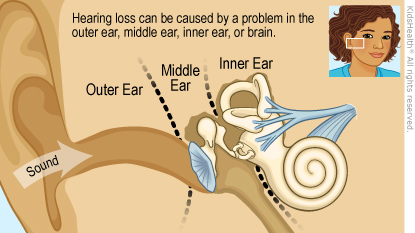Hearing loss in one ear with normal hearing in the other ear is called unilateral hearing loss (UHL). Kids with UHL may find it hard to understand what someone is saying, especially in noisy places. Treatment depends on what is causing the UHL.

To help your child at home:
- If your child needs to wear a hearing aid or use an amplification device, teach them how to use and care for it.
- To help your child hear and understand you:
- Get your child's attention before you start to talk.
- Be sure your child's better ear is facing you.
- Use facial expressions like smiling and gestures like pointing to help your child understand what you're saying.
- Do not have the TV, music, or loud appliances on when you talk to your child.
- Teach your child to ask, "Will you please repeat that?" if they did not hear something.
- Teach your child to use their ears AND eyes to check for cars and other dangers when riding a bike or crossing a street.
- To protect hearing, teach your child to:
- Avoid or move away from loud noises (such as from lawn mowers, power tools, and blenders).
- Wear protective earplugs or earmuffs if a loud noise can't be avoided (cotton in the ears does not protect hearing).
- Turn down the volume when listening to music.
- Take breaks about every hour when wearing earbuds or earphones.
- Go to all visits for follow-up and testing as recommended by your health care team.
To help your child at school:
- If possible, choose a child care or a school that has smaller rooms instead of one big room. Smaller rooms tend to be less noisy.
- Have your child sit close to the teacher with the better ear facing the teacher.
- Ask the teachers to repeat information and check for understanding. Written directions and outlines or summaries can help older children better understand what is said in the classroom.
- If your child needs more help, meet with the teacher and ask for a special plan, which may include a 504 plan or an individualized education program (IEP).

What are the types of UHL? The types of hearing loss include:
- Sensorineural hearing loss: when there is a problem in the inner ear or with the connection from the inner ear to the brain
- Conductive hearing loss: when there is a problem with a part of the outer or middle ear that blocks sound from going to the inner ear
- Mixed hearing loss: when both sensorineural and conductive hearing loss happen
- Central hearing loss: when the hearing part of the brain doesn't work properly
What is the treatment for UHL? Treatment depends on the cause of the hearing loss. Sensorineural and central hearing loss usually do not get better, but hearing aids or other treatments sometimes can help. Conductive hearing loss usually gets better after the cause is found and treated. For example, if a buildup of earwax causes the problem, it will get better when the wax is removed.
Can UHL cause other problems? A child who does not hear well may have speech and learning problems. It also can be hard to talk to and be with friends. Because hearing is normal in one ear, UHL is often diagnosed later than bilateral hearing loss. Identifying UHL and getting help early is the best way to prevent problems.
Who will be on my child's health care team? The care team will include:
- an ENT (ear, nose, and throat) doctor
- an audiologist (a specialist in hearing testing)
- a speech therapist
- other specialists, as needed



